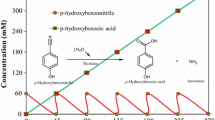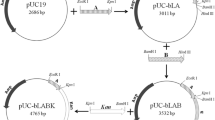Abstract
The biodesulfurization 4S pathway can specifically desulfurize an aromatic S heterocyclic compound (which is difficult to desulfurize by hydrodesulfurization) and maintain the integrity of its combustion value. The four Dsz enzymes in the pathway convert the model compound dibenzothiophene (DBT) into the sulfur-free compound 2-hydroxybiphenyl (HBP). DszC is the first enzyme in the 4S pathway and is subject to feedback inhibition and substrate inhibition. This study is the first attempt to further modify the DszC mutant AKWC to improve its tolerance to DBT. Alanine scanning was performed on the dimeric surface of the DszC mutant AKWC, and the HBP yield of the BAD (AKWCP413A) strain was increased compared to the BAD (AKWC) strain. Site-directed saturation mutagenesis was performed on the 413th amino acid of AKWC, and the substrate inhibition parameter KI value of the mutant AKWCPI was 5.6 times higher than that of AKWC. When the DBT concentration was 0.25 mM, the HBP production of the recombinant strain overexpressing AKWCPI was increased by approximately 1.4-fold compared to the BL21(DE3)/BADC*+C* strain. The protein engineering of DszC further improved the substrate tolerance after overcoming the feedback inhibition, which provided a reference for the analysis of the inhibition mechanism of DszC substrate. Overexpression of DszC-beneficial mutants also greatly improved the efficiency of desulfurization.






Similar content being viewed by others
Abbreviations
- HDS:
-
Hydrodesulfurization
- BDS:
-
Biodesulfurization
- DBT:
-
Dibenzothiophene
- HBP:
-
2-Hydroxybiphenyl
- DBTO2 :
-
Dibenzothiophene sulfone
- HBPS:
-
2-(2-Hydroxybiphenyl)-2-sulfonic acid salt
- HPLC:
-
High-performance liquid chromatography
References
Abin-Fuentes A, Mohamed ME-S, Wang DI, Prather KL (2013) Exploring the mechanism of biocatalyst inhibition in microbial desulfurization. Appl Environ Microbiol 79:7807–7817
Agarwal M, Dikshit PK, Bhasarkar JB, Borah AJ, Moholkar VS (2016) Physical insight into ultrasound-assisted biodesulfurization using free and immobilized cells of Rhodococcusrhodochrous MTCC 3552. Chem Eng J 295:254–267
Akhtar N, Akhtar K, Ghauri MA (2017) Biodesulfurization of thiophenic compounds by a 2-hydroxybiphenyl-resistant Gordonia sp. HS126-4N carrying dszABC genes. Curr Microbiol 75:1–7
Andres AF, Magdy El-Said M, Wang DIC, Prather KLJ (2013) Exploring the mechanism of biocatalyst inhibition in microbial desulfurization. Appl Environ Microbiol 79:7807–7817
Cunningham BC, Wells JA (1989) High-resolution epitope mapping of hGH-receptor interactions by alanine-scanning mutagenesis. Science 244:1081–1085
Denome SA, Olson ES, Young KD (1993) Identification and cloning of genes involved in specific desulfurization of dibenzothiophene by Rhodococcus sp. strain IGTS8. Appl Environ Microbiol 59:2837–2843
Dutta K, Venkata Dasu V, Mahanty B, Anand Prabhu A (2015) Substrate inhibition growth kinetics for cutinase producing Pseudomonas cepacia using tomato-peel extracted cutin. Chem Biochem Eng Q 29:437–445
Ferreira P, Sousa SF, Fernandes PA, Ramos MJ (2017) Frontispiece: improving the catalytic power of the DszD enzyme for the biodesulfurization of crude oil and derivatives. Chem Eur J 23:17231–17241
Gonzalez L, Scheller RH (1999) Regulation of membrane trafficking: structural insights from a Rab/effector complex. Cell 96:755–758
Guan LJ, Lee WC, Wang S, Ohshiro T, Izumi Y, Ohtsuka J, Tanokura M (2015) Crystal structures of apo- and FMN-bound DszC from Rhodococcus erythropolis D-1. FEBS J 282:3126–3135
Guan LJ, Lee WC, Wang S, Ohshiro T, Izumi Y, Ohtsuka J, Tanokura M (2015) Crystal structures of apo-DszC and FMN-bound DszC from Rhodococcus erythropolis D-1. FEBS J 282:3126–3135
Hino T, Hamamoto H, Suzuki H, Yagi H, Ohshiro T, Nagano S (2017) Crystal structures of TdsC, a dibenzothiophene monooxygenase from the thermophile Paenibacillus sp. A11–2, reveal potential for expanding its substrate selectivity. J Biol Chem 292:15804–15813
Martínez I, Mohamed MES, Rozas D, García JL (2016) Engineering synthetic bacterial consortia for enhanced desulfurization and revalorization of oil sulfur compounds. Metabol Eng 35:46–54
Kaiser PM (1980) Substrate inhibition as a problem of non-linear steady state kinetics with monomeric enzymes. J Mol Catal 8:431–442
Somayye K, Mahmood MA, Gheshlaghi R, Dehghani H, Rasekh B (2018) Construction and characterization of a new recombinant vector to remove sulfate repression of dsz promoter transcription in biodesulfurization of dibenzothiophene. Front Microbiol 9:1578
Khosravinia S, Mahdavi MA, Gheshlaghi R, Dehghani H (2018) Author correction: characterization of truncated dsz operon responsible for dibenzothiophene biodesulfurization in Rhodococcus sp. FUM94. Appl Biochem Biotechnol 184:897–897
Khosravinia S, Mahdavi MA, Gheshlaghi R, Dehghani H (2018) Characterization of truncated dsz operon responsible for dibenzothiophene biodesulfurization in Rhodococcus sp. FUM94. Appl Biochem Biotechnol 184:885–896
Kilbane JJ, Stark B (2016) Biodesulfurization: a model system for microbial physiology research. World J Microbiol Biotechnol 32:1–9
Kühl PW (1994) Excess-substrate inhibition in enzymology and high-dose inhibition in pharmacology: a reinterpretation. Biochem J 298(Pt 1):171–180
Li L, Liao Y, Luo Y, Zhang G, Liao X, Zhang W, Zheng S, Han S, Lin Y, Liang S (2019) Improved efficiency of the desulfurization of oil sulfur compounds in Escherichia coli using a combination of desensitization engineering and DszC overexpression. ACS Synth Biol 8:1441–1451
Liang Z, Xiaolu D, Daming Z, Zhe D, Kaihua J, Wuyi M, Guoqiang L, Xin L, Haitao Y, Ting M (2015) Structural insights into the stabilization of active, tetrameric DszC by its C-terminus. Proteins Struct Funct Bioinf 82:2733–2743
Martínez I, Mohamed ME-S, Santos VE, García JL, García-Ochoa F, Díaz E (2017) Metabolic and process engineering for biodesulfurization in Gram-negative bacteria. J Biotechnol 262:47–55
Martinez I, Santos VE, Gomez E, Garcia-Ochoa F (2016) Biodesulfurization of dibenzothiophene by resting cells of Pseudomonasputida CECT5279: influence of the oxygen transfer rate in the scale-up from shaken flask to stirred tank reactor. J Chem Technol Biotechnol 91:184–189
Matthews BW (1996) Structural and genetic analysis of the folding and function of T4 lysozyme. Faseb J 10:35
Mishra S, Panda S, Pradhan N, Satapathy D, Biswal SK, Mishra BK (2017) Insights into DBT biodegradation by a native Rhodococcus strain and its sulphur removal efficacy for two Indian coals and calcined pet coke. Int Biodeterior Biodegrad 120:124–134
Nsoe MN, Kofa GP, Ndi KS, Mohammadou B, Kayem GJ (2018) Biodegradation of ammonium ions and formate during ammonium formate metabolism by Yarrowia lipolytica and Pichia guilliermondii in a batch reactor. Water Air Soil Pollut 229:162
Pauli K, Pekka P, Belogurov GA, Pekka MNL, Keqian Y, Jarmo N, Mikko MK (2013) Tracing the evolution of angucyclinone monooxygenases: structural determinants for C-12b hydroxylation and substrate inhibition in PgaE. Biochemistry 52:4507–4516
Reed MC, Anna L, Frederik HN (2010) The biological significance of substrate inhibition: a mechanism with diverse functions. BioEssays 32:422–429
Shiheng L, Conggang Z, Tiantian S, Tiandi W, Deyu Z, Kang W, Yan H, Yuhui D, Kun Y, Sujuan X (2015) Crystal structure of DszC from Rhodococcus sp. XP at 1.79 ? Proteins Struct Funct Bioinf 82:1708–1720
Su T, Su J, Liu S, Zhang C, He J, Huang Y, Xu S, Gu L (2018) Structural and biochemical characterization of BdsA from Bacillussubtilis WU-S2B, a key enzyme in the “4S” desulfurization pathway. Front Microbiol 9:231
Todescato D, Maass D, Mayer DA, Oliveira JV, Oliveira DD, Souza AAUD (2017) Optimal production of a Rhodococcuserythropolis ATCC 4277 biocatalyst for biodesulfurization and biodenitrogenation applications. Appl Biochem Biotechnol 183:1–15
Weiss GA, Watanabe CK, Zhong A, Goddard A, Sidhu SS (2000) Rapid mapping of protein functional epitopes by combinatorial alanine scanning. Proc Natl Acad Sci USA 97:8950–8954
Wells JA (1991) Systematic mutational analyses of protein-protein interfaces. Methods Enzymol 202:390–411
Yoshino M, Murakami K (2015) Analysis of the substrate inhibition of complete and partial types. Springerplus 4:292
Zhang L, Duan X, Zhou D, Dong Z, Ji K, Meng W, Li G, Li X, Yang H, Ma T (2014) Structural insights into the stabilization of active, tetrameric DszC by its C-terminus. Proteins Struct Funct Bioinf 82:2733–2743
Acknowledgements
This research was financially supported by the National Natural Science Foundation of China (Grant No. 31470159) and the National Science Foundation for Young Scientists of China (Grant No. 31400062).
Author information
Authors and Affiliations
Corresponding author
Ethics declarations
Conflict of interest
The authors declare no competing financial interest.
Research involving human participants and/or animals
This article does not contain any studies with human participants or animals performed by any of the authors.
Informed consent
Informed consent was obtained from all individual participants included in the study.
Additional information
Publisher's Note
Springer Nature remains neutral with regard to jurisdictional claims in published maps and institutional affiliations.
Electronic supplementary material
Below is the link to the electronic supplementary material.
Rights and permissions
About this article
Cite this article
Li, L., Ye, L., Lin, Y. et al. Enhancing the substrate tolerance of DszC by a combination of alanine scanning and site-directed saturation mutagenesis. J Ind Microbiol Biotechnol 47, 395–402 (2020). https://doi.org/10.1007/s10295-020-02274-8
Received:
Accepted:
Published:
Issue Date:
DOI: https://doi.org/10.1007/s10295-020-02274-8




